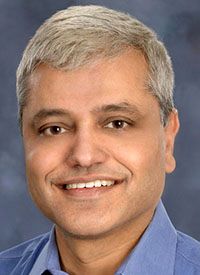Publication
Article
Overcoming Hurdles to Biosimilar Uptake
Author(s):
Sanjiv S. Agarwala, MD, explains that biologics have revolutionized the treatment of serious conditions, including cancer, over the past few decades, however, costs are a pressing issue for all providers and biologics are a major culprit.
Sanjiv S. Agarwala, MD

With the costs of biologic drugs increasing, biosimilars have emerged as an attractive option for containing costs and expanding access to treatment. However, some barriers to wider uptake still need to be addressed, according to a presentation at the National Association of Managed Care Physicians Virtual Spring Managed Care Forum.
Sanjiv S. Agarwala, MD, professor of medicine at Temple University, explained that biologics have revolutionized the treatment of serious conditions, including cancer, over the past few decades. However, costs are a pressing issue for all providers and biologics are a major culprit, accounting for half of Medicare’s drug spending in 2018.
As a melanoma specialist, Agarwala has used biologics for a long time, and they have “changed melanoma care completely and are curing people, but the cost is tremendous. Biologics are a major factor in both the success of cancer treatment and the costs,” he said.
Enter biosimilars—highly similar, though not identical, versions of biologics that are derived from living sources and have a complex manufacturing process. It’s important to note that biologics cannot have generics because they are too complicated, and, in fact, the biologics themselves undergo natural variability with time, making an identical copy of a biologic unnecessary because even the reference drug is not identical to itself over time.
That understanding has given rise to the current bio-similar approval pathway in which sponsors must only provide evidence that their drug candidate is not significantly different from the reference in terms of efficacy and safety. They are not required to repeat the clinical trials establishing the drug’s benefit or prove superiority over a placebo; instead, clinical studies are conducted with sensitive end points designed to detect any difference from the reference.
Agarwala outlined some unique issues relevant to biosimilars, including interchangeability, which would allow pharmacists to substitute a prescribed drug with a biosimilar but requires many different study designs; no biosimilars have received an interchangeable designation from the FDA yet. The naming of biosimilars also holds potential for confusion, which is why the FDA adopted rules using the core name and a unique suffix.
Aside from approval, there are challenges to biosimilar uptake in the reimbursement landscape. Although the FDA has approved dozens of biosimilars, far fewer are actually available on the market due to ongoing litigation. Also, the “rebate trap” that occurs when manufacturers of higher-priced drugs offer rebates for preferred status can muddy the waters of cost savings by allowing health systems to actually pay less for expensive biologics than they would for biosimilars.
However, there is increasing recognition among architects of value-based care programs that biosimilars can improve affordability, access, and outcomes. The lower price point of biosimilars can enable additional doses of biosimilars to be given to more patients in need.
Education and familiarity are key in helping providers and patients become more comfortable with biosimilars, Agarwala said. In oncology, for instance, prescribers are more willing to accept biosimilars for palliative care rather than curative treatment because they may feel like they have only one shot at curing a patient’s cancer. Misperceptions around biosimilars can lead to uncomfortable conversations with patients who receive a biosimilar that does not improve their outcome and feel that the reference product would have worked better, when in fact the biosimilar and the reference have the same level of efficacy.
Although reports have predicted large cost savings from biosimilar uptake, right now we have too little experience to assess their effect on lowering biologic spending.
“This mixture of collecting data to show that costs are going down and more people are getting access to it, coupled with the fact that these are fair to use—you’re not using some snake oil here; these are actual drugs [and] the FDA regulates how they can be approved—will help us,” Agarwal said.
“This problem is not going away,” he added. “Biologics are going to be the [agents] that cure cancer for us one day, so we’d better be ready to make them more affordable for everybody.”
Sanjiv S. Agarwala, MD, Professor of Medicine at Temple University in Philadelphia, PA









